Peter MALONE
Saturday, 18 September 2021 19:42
Son of Kong
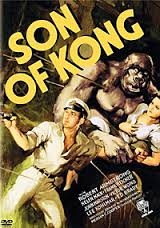
SON OF KONG
US, 1933, 70 minutes, Black and white.
Robert Armstrong, Helen Mack.
Directed by Ernest Schoedsack.
King Kong was a classic of its time. With special effects that were in advance of their day, the film made great impact. Audiences enjoyed it for its adventure and its fantasy – the echoes of the world of Edgar Rice Burroughs and other writers. However, somehow or other, the screenplay and the presentation of Kong made such an impact that he went into the realm of American myth.
There are overtones of the Beauty and the Beast theme, especially with the fascination of Kong for Fay Wray. There is genuine pathos in audience interest in and identification with Kong and for his being used by the humans. The climax in New York on the top of the Empire State Building is famous and audiences grieved for the death of Kong. Dino de Laurentiis' remake in the seventies kept much of the same atmosphere and the mythic qualities. However. the surprise element had passed and the film, while very enjoyable in its way, was probably too grandiose compared with the original.
There were many derivatives over the decades especially in Japanese adventure science fiction films for family audiences. The original creators ventured into a sequel, Son of Kong. However, it was very short, used some of the same effects for audience delight but its plot and its treatment of Kong were rather trivial.
1. The impact and success of 'King Kong'? Its reputation popularity? Its blend of adventure ingredients, fantasy, myth? The necessity of a sequel? The impact of a sequel? Its tone in comparison with the original? Comparisons of quality?
2. Its use of the original in similarities of plot, the star, the taking up of the story? The sequel as a postscript to the original for audience entertainment in the thirties, for later?
3. The impact of the note and the special effects? Their attraction, their technical skill for the time?
4. The establishing of the setting: the court cases after the carnage and death of King Kong, the Captain and his killing the circus owner and needing to get out of the port, Denham and his being attracted by the story of treasure, Hilda and her being in the circus, the death of her father, suspicions of his murderer, stowing away? The characters and the situations established by the conventions of the South Sea Island adventure?
5. How well did the screenplay set up the nature of the voyage, getting everybody on board? The buildup of the mutiny, the takeover?
6. The presentation of the island, the unfriendly natives, the party going ashore and exploring?
7. The impact of the son of Kong, the humorous tone - how successful? The presentation of the prehistoric world and the various monsters threatening the humans, the fights with Baby Kong, Kong rescuing the humans? The effect on each of the characters? The ultimate death of the Son of Kong and the irony of his slaying the villain? The implied heroism in the presentation of Kong?
8. The necessary rescue as the tidying up of the plot?
9. The basic values presented of right and wrong, good and evil, adventure, romance?
Published in Movie Reviews
Published in
Movie Reviews
Tagged under
Saturday, 18 September 2021 19:42
Sons of Matthew

SONS OF MATTHEW
Australia, 1949, 107 minutes, Black and white.
Michael Pate, Ken Wayne, Tommy Burns, John Unicomb, John Ewart, Wendy Gibb, John O’ Malley, Thelma Scott, Dorothy Alison.
Directed by Charles Chauvel.
Sons of Matthew is the second-last film made by pioneer director Charles Chauvel, co-written with his wife Elsa Chauvel. They were to make Jedda in 1955.
The Chauvels had been making films since the 1920s, making such striking films as Heritage and Uncivilised in the 1930s and the war films, Forty Thousand Horsemen and Rats of Tobruk as part of the war effort.
This is a pioneering story of the Green Mountains near the southern Queensland coast. The film shows the O’ Riordan family clearing the land (felling many trees which might cause some consternation in later decades). However, the film is important in terms of a picture of pioneering families in Australia. The O’ Riordans have many children, have a Catholic background, are dedicated to hard work. The film shows the varous sons and their families, the struggles, the clashes, the reconciliations, the hopes.
The film starred Michael Pate who was soon to go to Hollywood and perform in a number of character roles (often ethnic non-white American roles). Dorothy Alison, who portrays Rose O’ Riordan, was to go to England for a long career. Both Michael Pate and Dorothy Alison returned to Australian film and television during the 1970s.
1. An epic Australian film? Picture of pioneering years? Nationalism? Human stories?
2. The work of Charles Chauvel and his vision? This film within his canon of film? Similarities of themes? The epic treatment? The film's success in its time? Later?
3. The quality of black and white photography, locations? The special effects especially for the seasons, cattle and horse sequences, bushfires and floods, work? musical score? The atmosphere of New South Wales and the mountains of Queensland?
4. The cast and the device of the photo album, the commentary on each of the characters? Information and emotional response? The quality of Wilfrid Thomas's commentary? Indicating events, understanding of events, judgments, emotional response to Australian nationalism and the pioneers?
5. The portrait of the O' Riordan family: the Irish and English backgrounds? The characteristics of the Irish and the English? An ordinary family? Pioneering, work, home? Drought, fire, flood? The terrain? The opening up of the Australian outback and taming it? The building up of a family? The portrait of the Australian- Irishman, the English- Australian woman? The uncle and his work, remaining single, devotion to the family? The sense of family? The friendship with the Mc Allisters - the scene of the bathing of Kathy? The birth of the children and the counterpointing of Shane's birth with the trouble with the horses? The symbolism of difficult birth?
6. The range of boys and girls in the family? The emphasis on the boys? The background presence of the girls? Shane and his growing up the eldest, his responsibility? Michael as the youngest? the emotional impact of the recitation of the Our Father and his prayers? (The focus on Irish Catholicism during the early years? its later absence?) Jane and her care for the family while her husband was droving, the build-up to the celebration of Christmas, no gifts for Michael because of the drought, the family setting to to make toys, her making toffee?
7. The droving and the prolonged absences of the men? Christmas and the bushfires? The Mc Allisters burnt out and the deaths? Fighting the fire, the spirit of fighting the fire, the children and all helping? The uncle and his decision to go north? Matthew's decision to stay? The passing of the seasons and new prosperity?
8. The sons of Matthew continuing their father's tradition and droving, the return and the jovial atmosphere, the horseplay - especially with Michael? The family's style, spirit? Matthew's meeting with his sons and the discussion of the future and their moving north?
9. Shane and the organisation of the sons to go north? The Mc Allisters going as well? The difficulties for Kathy? and the emphasis on the strong pioneering spirit for man and women? Setting out, the journey, the Queensland town and the girls farewell? The trek through the mountains, the hard terrain? The difficulties of the mountains and their peaks? and the possibility of falling? Clearing the trees, the collage of felling the trees, clearing the jungle? The camping life, the incessant work, the rest, the trips to the town for supplies? The ruggedness of pioneering? The hopes for prosperity?
10. The focus on Shane and his seriousness, his command of the other brothers, respect for him, the rules? His love for Kathy but not expressing it indicated with tension? The manifesting of his love? Rejection of Kathy? His decision to take her away from Barney? The clash and the fight? Saving Kathy from the flood? His injury? His return? His becoming the new patriarch figure of the next generation?
11. Kathy and her place in the O' Riordan home, everybody talking about her being in love with Barney? Taking it for granted? Her not feeling it? Her going north, working, being one of the men? The unemotional engagement and her sadness? Her discussions with Shane and his rejection of her? Her decision to do her duty? The monsoon and the rescue? Shane's choosing her? Chauvel's ability to create at atmosphere of sexual tension? The background of duty and honour?. Honour among brothers and yet the audience knowing Barney as worthless?
12. Barney and his toughness, Selina and the girls in the town, his double standards? Luke and the younger son? The fight in the bar? Their work to build up the family property? Barney's injuring Shane and the feeling in the fight ? and his atoning?
13. Luke, Michael and the younger brother and their sharing, the jokes about Michael, Luke's help, the younger son being more sensitive but having to become a man in the rugged situation?
14. The sketch of the town, the people, the girls, supplies, their attitude towards the O'Riordans, the fight in the bar?
15. The achievement, the clearing of the jungle, the introduction of cattle?
16. Jane and her coming north, her speech, disgust with Barney, the reconciliation?
17. The epilogue with its picturing of the achievement of the family, their becoming part of the aristocracy of the land - generations, servants, wealth? A picture of the transition from 19th to 20th century Australia?
Published in Movie Reviews
Published in
Movie Reviews
Tagged under
Saturday, 18 September 2021 19:42
Snapshot
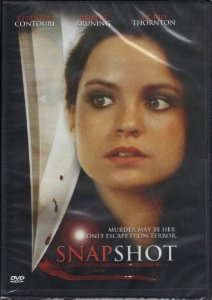
SNAPSHOT
Australia, 1979, 101 minutes, Colour.
Robert Bruning, Sigrid Thornton, Hugh Keays- Byrne, Denise Drysdale, Vincent Gil, Julia Blake, Peter Stratford, Chantal Contouri.
Directed by Simon Wincer.
Snapshot is an Australian thriller, one of many screenplays written by Everett de Roche (Patrick, Long Weekend, Harlequin, Road Games at this particular period). The film was directed by Simon Wincer who made Harlequin, went on to make Phar Lap and The Lighthorsemen as well as to have a very successful career in Hollywood directing many films and television miniseries including Lonesome Dove.
Sigrid Thornton portrays a young girl who has a puritanical mother, is kicked out of home, is a shy hairdresser, becomes mixed up with the fashion worls, accidentally becomes a model and involved in a world with some sleazy characters. However, her boyfriend, an ice cream van driver, starts to stalk her.
Since the film is a thriller, there are a number of twists which are enjoyably satisfying.
1. The title, its tone, background of models and photography, films? The focus on Angela and her work, modelling, attitudes towards this? Themes from this kind of world? The use of Angela's photo in the magazine, by Elmer?
2. How we11 did the film use the conventions of the thriller genre? Characters, situations, menace, deaths, mystery? Audience interest and involvement?
3. The quality of the Panavision colour photography, the presentation of the city of Melbourne, the suburbs, the beaches, the environment? Modern Melbourne society? The media set? The use of editing, the thriller effects?
4. The score and its thriller conventions style? Contribution to atmosphere? The song about Angela during the photography session?
5. The opening with the firemen and the atmosphere of mystery, the burnt man? The flashbacks from the snapshots covering the floor and walls and roof? Angela running through the city? The mystery of the identity of the burnt man? The mystery of Angela's connection with him? The seeing of the events again especially Madeleine's grief? Angela and her presence, Daryl? The aftermath and the revelation of Madeleine's guilt?
6. The strength of Sigrid Thornton's performance as Angela? The strength of the film? As person, personality? Attractive, appearance? At work at the hairdresser's, the interchange with the manager? Seeing her at home, her sister and her comments, her mother's attitudes? The confrontation with her mother, moving out, being locked out, the photograph, the money and her mother taking it? The long relationship with Daryl? Daryl and his 'Mr. Whippy' truck? The friendship with Madeleine ? and the lack of explanation? Angela as an average girl in Melbourne?
7. Madeleine's character as indicated by her glamour, driving, attitude towards hairdresser and advice to Angela, arranging for the job? The indications of her lesbianism? Seeing her at the party and her jealousy towards men approaching Angela? The presentation of Elmer and the quality of her marriage? Her presence with Angela, comforting her? Her saying goodbye stoically and yet her behaviour in arranging the ticket, Daryl's death? How credible was her behaviour especially with the pig's head? A credible villainess for the film?
8. Madeleine's introduction of Angela to Lindsay? His absent?mindedness, as a photographer, the dead mouse., his explanation to Angela of photographing dead flora and fauna? His house, the group of people who lived there? Lindsay at work, his kindness in letting Angela stay? The group of people who lived there, the friends and their advice? Angela's friendship with them?
9. The introduction to Elmer, his presence at the restaurant, the arranging of the meeting, the meal and his seduction technique, his story, the photography? The irony of his phone number and Angela going to him? His menace and mad threats, the poetic justice of his being the burnt man?
10. The character of Daryl? His infatuation for Angela, love for her? Angela's sister and her comments? His continued following, the 'Mr Whippy' truck and its ominous presence? Angela suspecting him as regards the pig's head etc.? The various chase sequences? The presence of the truck at the end and the irony of Madeleine's killing him with his truck? As a character, his genuine love for Angela?
11. The picture of the various men, their attitudes towards Angela, wanting to use her, modelling, business? The old man on the beach watching her during the filming?
12. Angela changing as a character throughout the film? The attraction of the money and her plans to go overseas, independence? Madeleine persuading her to do the modelling? Dress, nude sequences, the beach? Her attitude towards being photographed? Her initial reaction to seeing her face appearing in the photograph, her liking it? Her relationship with Lindsay and relying on him when she was locked out of the house? The conflicts with Daryl and her hurting him? Her presence at the various parties? Her decision to leave Elmer's and not be compromised? The encounter with her mother? The dress, being slashed, the pig's head? How credible was her behaviour, the decision to go to Fiji, Elmer's photography and her escaping, Daryl's help? Her decision to go with Madeleine at the end ? to what, how credibly (in the light of her reaction to Madeleine's amorous advances?)
13. The character sketches of Angela's mother, sister, the hairdressers? The crew for the filming? The singing groups?
14. The return to the burnt man, the resume of what had gone before? The effectiveness of the stunt work?
15. The ugliness of Daryl's death and Madeleine's appearance? How credible Angela's final behaviour?
16. The success of the film within its limitations and the thriller conventions? Its picture of life, society, its portrait of an individual?
Published in Movie Reviews
Published in
Movie Reviews
Tagged under
Saturday, 18 September 2021 19:42
Snowbeast
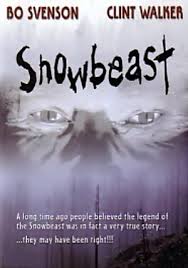
SNOWBEAST
US, 1977, 86 minutes, Colour.
Bo Svenson, Yvette Mimieux, Sylvia Sidney, Robert Logan, Clint Walker.
Directed by Herb Wallerstein.
Snow Beast is a telemovie that is capitalising on the atmosphere of films such as Jaws. In fact it imitates the technique of Jaws in many ways, a especially the subjective impressions of the monster with glimpses of him. This is only partially successful in creating a sense of menace, danger, death and destruction.
Bo Svenson has been reliable as a tough laconic hero in many films and repeats his performance here. Yvette Mimieux is a standard heroine. Sylvia Sidney plays a supporting role. It is average entertainement of a monster, a big foot menacing people at a ski resort.
1. An entertaining adventure telemovie? In the disaster trend?
2. The conventions of the genre: the isolated situation, the tourists, the hero, heroine, sheriff, people who are destroyed by the beast? The emphasis from 'Jaws' of not seeing the boast but feeling its menace? A satisfying derivative example of the genre?
3. Colour photography, snow locations, authentic atmosphere? Music? Special effects, especially the destruction sequences?
4. How credible was the plot: the menace at a ski resort, the people there, the tracking of the beast, the explanation of the beast and its violence, its cravings, return to its scene of destruction? The confrontation? Sufficient for the purposes of the entertainment and themes?
5. How well drawn were the main characters? Gar and his presence at the ski resort, his work, strength, skill? Tony Rill and his presence? Contrast of character? The sheriff and his confrontation of the snow beast? Ellen for romantic presence? Carrie and the tough old lady running the ski resort? The personalities of the various people destroyed and menaced? Character sketches, particular types for this kind of entertainment?
6. The special effects with the presence of the beast, its destruction, menace, tracking, confrontation?
7. The atmosphere of suspense, crises? Memorable sequences?
8. The usual themes of heroism, danger, good and evil?
Published in Movie Reviews
Published in
Movie Reviews
Tagged under
Saturday, 18 September 2021 19:42
Snoopy Come Home
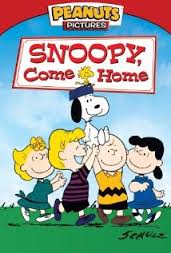
SNOOPY COME HOME
US, 1972, 81 minutes, Colour.
Voices of Bill Melendez, Chad Webber, Robin Kohn, Stephen Shea, David Carey, Johanna Baer, Hilary Momberger.
Directed by Bill Melendez.
Snoopy, Come Home is one of several full-length feature films directed by Bill Melendez from Charles Schulz’s cartoon strips. Melendez had worked in animation since the early 1940s. His career lasted sixty years. He made a number of short Charlie Brown films in the 1960s, then a feature film, You’re A Good Man, Charlie Brown. He continued to make short films about Charlie Brown until 2003.
This film focuses on Snoopy, his going back to his previous owner, Lila, deciding he should stay with her. In the meantime, Charlie Brown, Lucy and Linus are searching for him.
1. Who do the characters appeal to? Do they appeal as much on the screen as they do in the comic strip? What is the nature of their appeal?
2. What is particularly characteristic of the animation of the characters? Is this in evidence in the film? Was there a good use of drawings, colour?
3. Did the songs add anything to the film? The song, No Dogs Allowed?
4. Take each of the principal characters and discuss one's response to each of them, especially Snoopy, Charley Brown, Lucy, Linus, Schroder, Woodstock. How did the film visualise particular comic strips? This was in evidence at the beginning, especially about Charley Brown. What moral did these comic strips point to especially about Charley?
6. Why the particular appeal of Snoopy? What does he stand for?
7. The importance of Snoopy and the picnic at the beginning of the film? What insight into Snoopy? What atmosphere for the film? Snoopy's visiting? His concern and care and going on the visit? Snoopy's visit as a kind of odyssey? Consider the particular adventures that he met on the way, his camping, the people that he met, the refrain of No dogs allowed.
8. Why was Snoopy's visist so successful? What happiness did he bring? What effect did it have on the others? the significance of his decision to leave Charlie Brown? Why? The impact of the sequence of the speeches? The irony of the bone? The even stronger irony of his return?
9. The reactions to his return and the retrieval of gifts? The sincerity of Charley Brown as always?
10. The parables of Peanuts are always considered important. How did this film contribute to the parable value of the Peanuts comic strip?
Published in Movie Reviews
Published in
Movie Reviews
Tagged under
Saturday, 18 September 2021 19:42
Smoke Signal
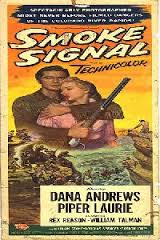
SMOKE SIGNAL
US, 1955, 88 minutes, Colour.
Dana Andrews, Piper Laurie, Rex Reason.
Directed by Jerry Hopper.
An enjoyable, if conventional, western. It was directed by Jerry Hopper, director of many action films at Universal and Paramount in the 50s. He directed several Chariton Heston films including Secret Of The Incas and the Private War Of Major Benson. The film was made at a time when there was a reappraisal of Hollywood's attitudes towards Indians. There was an emphasis on peace and reconciliation. Dana Andrews was competent in this kind of role and Piper Laurie has a subdued character to portray.
1. An entertaining western? The appeal of the western? The focus on the cavalry, the Indians? Reconciliation with the Indians?
2. The conventions of the western? The establishment of the fort, the personalities of the soldiers? The role of the Indians? The presence of a girl at the fort? The dangers, the chase? Jealousies, authority, antagonism? Heroics? The happy ending? This material as average, above average?
3. Colour photography, the use of Arizona and Grand Canyon locations? Colour? The musical score?
4. The American heritage and the stories of cavalries and Indians? Indian uprisings? The authentic historical background of the 1860's? .the Indian way of life and antagonisms? The military whites and their provoking of wars? The need for peace?making? Halliday and his role with the Indians, peace?making, his Indian wife? Laura and her relationship with her father, with Wayne, with Halliday? Captain Harper and his vengeance and the letter of the law? Wayne and his duty, antagonism towards Halliday? his cruelty? The portrait of the trapper, the soldiers? The possibility of the escape down the Colorado River and its rapids?
4. Halliday as hero - a sombre type, military background, personal loyalties, his attitudes towards Laura's father, his going to make peace, War Arrow and his acceptance of Halliday, the charges against Halliday for treason and murder? His saving the white man's life? His recapture? The lack of possibility for court martial, his advice, Harper's antagonism? His role during the journey down the river? Advice, heroics, saving life? Wayne's attempt on him? Attraction towards Laura, the hesitation especially about his Indian woman, reconciliation? The loyalty of the men? Harper's letting him escape to make peace? The American hero type?
5. Laura and her presence at the fort, relationship with Wayne, Captain Harper and his justice? her support of her dead father? Interest in Halliday, appreciation, falling in love? Her facing the truth about her father's attitudes? Wayne and his attempt on Halliday's life? The happy ending?
6. Captain Harper and his command, getting the men back into the fort at the opening, his decisions about Halliday, personal vengeance, the letter of the law, his sending the scout to his death, the journey down river and his suspicions, his final relenting? The pressure of the men?
7. The scout and his role with the group, the various men in the troop, the man blinded, the scout loyal to Halliday and killed? The teaming of the men in support of Halliday? Their skill in getting the group down the river?
8. Wayne and his being a good lieutenant, the letter of the law, his feelings towards Laura, antagonism towards Halliday, the attempt on his life, his death?
9. The Indians pursuing the white men, provoked into action? The pursuits?
10. The various crises in the trek down the river? The spectacular photography, the special effects ? rear projection for many of the river scenes? Taking away from the realism?
11. Themes of the American heritage? the heroism of the 19th century, pioneering, the military and the letter of the law, the misunderstanding of the Indians, the provoked uprisings, the need for peace?
Published in Movie Reviews
Published in
Movie Reviews
Tagged under
Saturday, 18 September 2021 19:42
Small Town in Texas, A
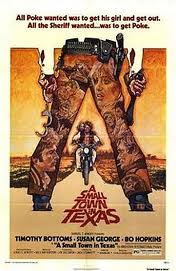
A SMALL TOWN IN TEXAS
US, 1976, 96 minutes, Colour.
Timothy Bottoms, Susan George, Bo Hopkins, Morgan Woodward, Art Hindle.
Directed by Jack Starrett.
A Small Town in Texas is a violent contemporary western. Timothy Bottoms portrays a young man who comes out of jail to meet his girlfriend but finds she has taken up with the sheriff and he is framed by the sheriff on a drug charge. He also witnesses the sheriff committing a murder. This sets up a confrontation between the two – with the hero either escaping or standing up to the sheriff.
Timothy Bottoms was a popular star in the 1970s with such films as The Last Picture Show and Love and Pain. Susan George had come from Britain after appearing in a number of films including Straw Dogs. Bo Hopkins was a regular in action films of the 1970s. Director Jack Starrett made a number of tough action films and television programs during these years including Cleopatra Jones, Slaughter, Race with the Devil.
1. The focus of the title on the town, localizing it in Texas, the overtones of Texas? Yet indefinite enough to give a universal theme?
2. Texas and the background of the 19th century West, Texas in the 20th century still in the West, expectations about Texas, America, American small towns?
3. The colour, the recreation of the town, the farms, the roads? Panavision? Music?
4. How ugly was the small town in Texas, its atmosphere, people, political and moral corruption, injustice? How pessimistic was the outlook of the film? How much hope about human nature? society? The individual in society?
5. The device of having the audience enter the theme and the town with Poke? The audience identifying with him? What kind of character was Poke? A limited young man? Slow-witted? The audience seeing and feeling the town and its people with this kind of man?
6. Poke's strengths and weaknesses as a character? The charge and the drug situation of five years earlier? How much justice had been done wibh such a sentence, such a sentence being served? Audience judgement about the justice and preparation for further Injustice towards Poke? How did the film communicate his sense of bewilderment on his return from prison, arriving in the town, people's attitudes, meeting him and remembering him, his visit to the farmhouse, the discovery of his girlfriend's infidelity, seeing his son again, being immersed in the problems of the town?
7. Mary Lee as a character, her relationship with Poke, her youth, waiting five years for him, Kevin and her mothering of him? Her relationship with Duke? An ordinary character involved in situations bigger than those she could cope with? Her involvement with Kevin in the great chase? A convincing small town character?
8. Duke as the contrast with Poke? His role in securing Poke's imprisonment, his rising to Sheriff? His smugness, liaison with Mary Lee? The gradual discovery that he was dishonest and corrupt? His being in the pay of the big business interests? Audience response to the revelation that he was an assassin? The build?up of his vengeance on Poke after his discovery about the money? His toadying to Crane? Being rejected by him? The desperation of his chase, vindicating himself, getting the money? The poetic justice of his death? An evil character who had the same chances as Poke?
9. How did the film build up Poke's predicament, the fair, the political background, seeing the assassination, discovering the money? His decision to take the money, go away, get the bike? His dependence on his friends? The chase and the irony of his being wanted as a killer? His not being believed, his being categorised? The necessity for escaping, getting Mary Lee and Kevin? The reaction to Duke's death? The importance of his returning to clear his name?
10. The film's portrayal of the big men in small towns and their business interests, corruption, using people, using assassinations? Crane and his duplicity? was it credible? His use of Duke, rejecting him?
Published in Movie Reviews
Published in
Movie Reviews
Tagged under
Saturday, 18 September 2021 19:42
Slippery Slide
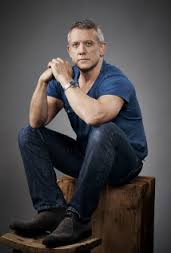
SLIPPERY SLIDE
Australia, 1980, 58 minutes, Colour.
Simon Burke, John Waters.
Directed by Donald Crombie.
Slippery Slide is a brief telemovie, sponsored by the Tasmanian Film Commission For Government Welfare Agencies. Direction is by Donald Crombie, maker of such feature films as Caddie, The Irishman, Cathy's Child. He also made an acclaimed short telemovie, Do I Have To Kill My Child? The film is strong in its cast, especially with Simon Burke from The Devil's Playground and John Waters. There is excellent photography, precise editing and the film has strong content as well as for such a brief film. It was intended for discussion and it achieves this well.
1. The impact of the film, entertainment, message? Brevity and impact? The strength of the plot, characterisation? The impact of the message and audience response to it? The government sponsorship?
2. Tasmanian production, interstate cast, director? The technical credits?
3. An atmosphere of realism in plot and character? Contrived for the purposes of the film and brevity? Observation of social situations and problems, portrayal of complex issues? The film's judgment on its characters, on society? Audience judgment?
4. The significance of the prologue: indication of facts, creation of a mood, a statement about situations in past decades, about the law and its administration, personal feelings of people involved? Parents and their ability to look after their children, failures? Adoption? The prospects for the neglected and then adopted chilaren?
5. The portrayal of foster parents? appropriately, fairly? The Dixons and the reasons for adopting Steven, the sense of duty, wanting to help? The effect on the husband and wife, their home life? What they gave to Steven over the years? The initial surface happiness? Tensions? The importance of the grandfather coming and claiming Steven's room, the parents allowing the grandfather to have it? The history of the grandfather's coming? The plea for himself to stay there and his not wanting to stay in the home? The family unable to cope? Steven and his place in the family, his calling his foster parents Mum and Dad, his knowledge that he was adopted? Going to the disco, their concern? The return and his lateness? His going to the courts, his behaviour, especially with taking the car and being chased by the police, the parents refusing to take him back, the growing rejection? Their return visit and the failure in being able to establish family patterns again?
6. The portrait of Steven's real mother and father? His father and the letter, the romanticism, Steven's unwillingness to face the facts, his hitchhiking and taking the car? His mother and her de facto husband? Her love for her son yet her inability to do anything about it? The hostility of the de facto husband? The cruelty experienced by Steven from his real parents?
7. The portrait of Steven as a boy of the 70s? The memory of his brother's death and its effect on him? The importance of his memories? His going to the dance, winning a prize, school sequences, playing truant and seen by his father, taking the car and being chased by the police, the car to go to see. his father, the encounter with the homosexual driver, his love for Alana and the problem of the abortion, his participating in the robberies? The anger within him, fears, always in reaction? His going to the courts, under parole, the friendship with David Wilding and the possibility of rehabilitation? The boys' home, the jokes, his fear of getting used to it? The sequences illustrating his life in the home? Getting the flat, Doug's return and Steven's smashing everything? The significance of his final words for his future?
8. The contrast with Alana and her being with the Methodist family, strictness, her attitudes and behaviour at the dance, flirting, Doug, the pregnancy, wanting to have the abortion, the robberies, the flat and her siding with Doug against Steven?
9. David Wilding and his representing compassion? The possibilities of helping Steven, seeking him out, taking a firm stand? The meetings of the parole board intercut with Steven's behaviour? The significance of his plea to the board? The flat? His visit to Steven in the home? The helplessness in the compassion?
10. The portrait of Australian society - perennial problems, the challenging of values; people trying to cope, hardness of attitudes, chances for children, managing to cope with problems, the role of the law, institutions, prison? Hopes, reforms? Compassionate awareness? What was the audience left with?
Published in Movie Reviews
Published in
Movie Reviews
Tagged under
Saturday, 18 September 2021 19:42
Sleeping Car Murders, The/ Compartiment Tuers
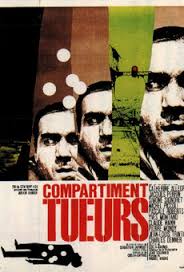
THE SLEEPING CAR MURDERS (COMPARTIMENT TUERS)
France, 1965, 95 minutes, Black and white.
Catherine Allegret, Jacques Perrin, Simone Signoret, Michel Piccoli, Pascale Roberts, Yves Montand, Charles Denner, Jean-Louis? Trintignant, Bernadette Lafont.
Directed by Costa-Gavras?.
The Sleeping Car Murders is a thriller, the first feature film by Costa- Gavras. However, in four years he was to become famous worldwide with his Oscar for the political film, Z. He had a very successful 1970s with his very strong political films after Z. They include The Confession, State of Siege, Special Section. In the 1980s he made Missing and Hanna K., as well as the American films Betrayed (about the Ku Klux Klan), and Music Box (about Nazi war trials). In the 1990s he made Mad City in the United States with John Travolta about a siege and the work of a journalist. Finally he made Amen, a film version of Rolf Hocchuth’s (**IMDB: Hochhuth) The Deputy, the film attacking Pius XII for collaboration with the Nazis.
This film is an entertaining murder mystery – enhanced by a top-rate cast of distinguished French actors.
1. The appeal of the murder mystery, the crime, clues, puzzle, characters? Detection? The quality of this murder mystery in terms of puzzle and clues, detection?
2. A French murder mystery, the use of so many prominent French film stars, the career of the director whose main interest was political? Black and white photography, Cinemascope, contemporary music and suspense themes? Possibility of audience identification with characters?
3. The atmosphere of the train, the movement of the train, the compartment, the transition to Paris, the city, police department, police work? Audience interest in the police work?
4. The introduction to the crime and detection via Daniel and Bambi? sympathy for them? Their stories of coming to the city, running away from school, hiding in the toilet and avoiding the ticket collector? The gradual involvement of Daniel, the danger to Bambi, their involvement in the crisis and the solution? The fact that they were young, audience attraction towards the young?
5. Was the film fair in presenting the mystery, sufficient clues?
6. The personality of the inspector, his role, boss, style, cold, his meeting with his wife, his work with his assistant, the continual harrassment? His clarity in working? His putting the clues together finally? A good example of a congenial detective?
7. The portrayal of the witnesses, their families? How real did the crime seem with such attention to detail on the train, the interviewing of various witnesses and family? The dead woman's sister and brother?in?law and their incessant talking? The workerwho was murdered and the sadness of his wife?
8. The focussing on Cavour on the train, his lustful attitudes towards the victim? Her brushing him off? The visualising of his story, his worry about reporting to the police, his visit to the boxing match, the impact of his being killed? A good character sketch of such a man?
9. The character sketch of Elaine Darras? As an actress, her style, her image of herself? On the train, her apartment with the gigolo? Her reaction towards the police? Her involvement in the mystery? The device of the letter being read by Daniel and Bambi? The visualising of the letter and the flashback technique for revealing the character of Darras, her work, visit to the vet with dog, growing infatuation with Eric? The ups and downs of their relationship, his youth, her age, her infatuation? The meaning of money? The clue to the ultimate solution of the mystery? Her murder and its impact? An effective character study of this kind of woman?
10. How important was Eric? The delineation of his character, work as a vet, his leading on of Elaine Darras, his life as gigolo? Gradual revelation of his involvement? His menacing Daniel in the bar? His breaking down and confessing to the police? A credible kind of villain?
11. The first victim's boyfriend, his incessant chatter, his being framed as regards collecting the money, the humour and irony of his critique of the police?
12. The character of the assistant detective, his access to information, his motivation for the crime? The fact that he took Daniel's phone call? The buildup to the denouement? Daniel in the phone, the hotel and the rescuing of Bambi? The build-up to the chase, the crash and the shootout? The murderer killing himself? An appropriate build-up of suspense for this kind of murder mystery? Audience interest and sympathies?
13. How much genuine character study is there in this kind of film? Analysis of human nature, good and evil, crime?
Published in Movie Reviews
Published in
Movie Reviews
Tagged under
Saturday, 18 September 2021 19:42
Slaves
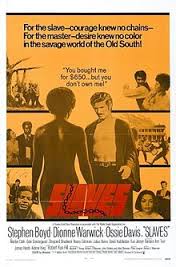
SLAVES
US, 1969, 110 minutes, Colour.
Ossie Davis, Dionne Warwick, Stephen Boyd, Nancy Coleman, Julius Harris, David Huddleston, Gale Sondergaard, Shepperd Strudwick.
Directed by Herbert J. Biberman.
Slaves is a film about a revolt in the south, a Kentucky slave who is sold to a cruel master (who has a black mistress). The slave is played by Ossie Davis, the master by Stephen Boyd and the mistress by singer Dionne Warwick.
The film is conventional in its presentation of slavery as well as the revolt. However, the film is of historical interest because of its co-writer director. Herbert J. Biberman was one of the Hollywood Ten, blacklisted from Hollywood along with his wife, Oscar-winning actress Gale Sondergaard. Biberman had made The Master Race in 1944 and was only able to make another film, independently about a New Mexico civil and industrial disturbance, Salt of the Earth, in 1954. Slaves was his only film after Salt of the Earth and the first film that Gale Sondergaard was able to appear in for twenty years.
The film is interesting insofar as it offers a perspective by Biberman with his own experience of oppression in the United States.
1. The emphasis of the title and indication of theme? Slaves as a film of the late 1960s? Reflecting American concerns at the time? Subsequent impact?
2. The quality of the colour, locations? The re?creation of 19th century atmosphere? The use of music and song?
3. Did the film have a 1960s outlook on America, blacks and the slave issue? America and its conscience and guilt?
4. The importance of the opening sequences? The sympathetic master? The Stillwell household and the way it was run? The possibilities for slaves? Luke and his ability to prosper in this situation? Stillwell caught by the machinations? The pressures on him to sell his slaves, though unwillingly? Fate and the impossibility of escaping it?
5. The film's focus on Luke? His status in the Stillwell household, taking its name? The fact that he had to be sold? The importance of the sequences with his wife?
6. The impact of the sale? The separation of husband and wife, the grief, the sense of hopelessness? The emotional response of the audience to this?
7. How well presented was the slave market at New Orleans? The nature of the sale, the humiliation of the slaves and their presentation, the comments of the buyers, the corments of the New Orleans lady about slavery?
8. McKay? as seen in this particular context? Being introduced to him in New Orleans? How did he typify the plantation owners and the slave masters? The vigorous young man and his arrogance? his sympathy towards black culture, the decorations and adornment of his house? his mistress? And yet his sadistic attitudes towards the slaves? His torture and the details of his humiliating of the slaves? The ambiguity in the American slave owner? How plausibly explored was this theme?
9. The character of Cassy and her role in this household? Her hair and clothes, her status? Yet her humiliation and her drinking? Her attitude towards McKay? Her attitude towards Emmaline as she came into the house? Her wanting to kill McKay? Luke's influence in persuading her not to? Her desperate need to escape?
10. What happened to Luke in this new household? His standing on principles, his mouthing of his religious beliefs and their being tested? His torture and whipping? His determination that the little baby should not be a slave? His involvement in her birth? His plans for the escape? The fatality of his death? How futile was Luke's life?
11. The characterization of Jericho, his sale, his place in the Mc Kay household, his torture, his escape?
12. The importance of the presentation of the details of the slaves' life, their work In the fields, their housing conditions, the humiliation, the sexual abuse etc.?
13. McKay? and his friends? The landowners? The criticism of the cousin from the north? His drunkenness and his almost being killed? His killing of Luke?
14. The fire and its effect on McKay?
15. The savagery after the escape? The fact that there were more blacks to pursue? This as a condemnation of the arrogant attitude of the Americans?
16. Critics were very hostile to the film. Why? They said it was pretentious and a set?back to civil rights causes. Is this evident from the film? how well did the film explore America and its racial heritage? questions of human dignity, slavery and freedom?
Published in Movie Reviews
Published in
Movie Reviews
Tagged under